Abstract
Human T cell hybridomas were produced by fusing the hypoxanthine phosphoribosyltransferase-deficient line of the human T cell lymphoma Jurkat with a continuous line of normal human T cells specific for tetanus toxoid (TeT). The hybridomas were selected for their ability to produce interleukin 2 after exposure to TeT on semiautologous monocytes and for their ability to bind to TeT-pulsed semiautologous monocytes. These antigen-specific T hybridomas demonstrated potent helper activity for semiautologous B cells as determined by the production of high levels of anti-TeT antibody in vitro.
Full text
PDF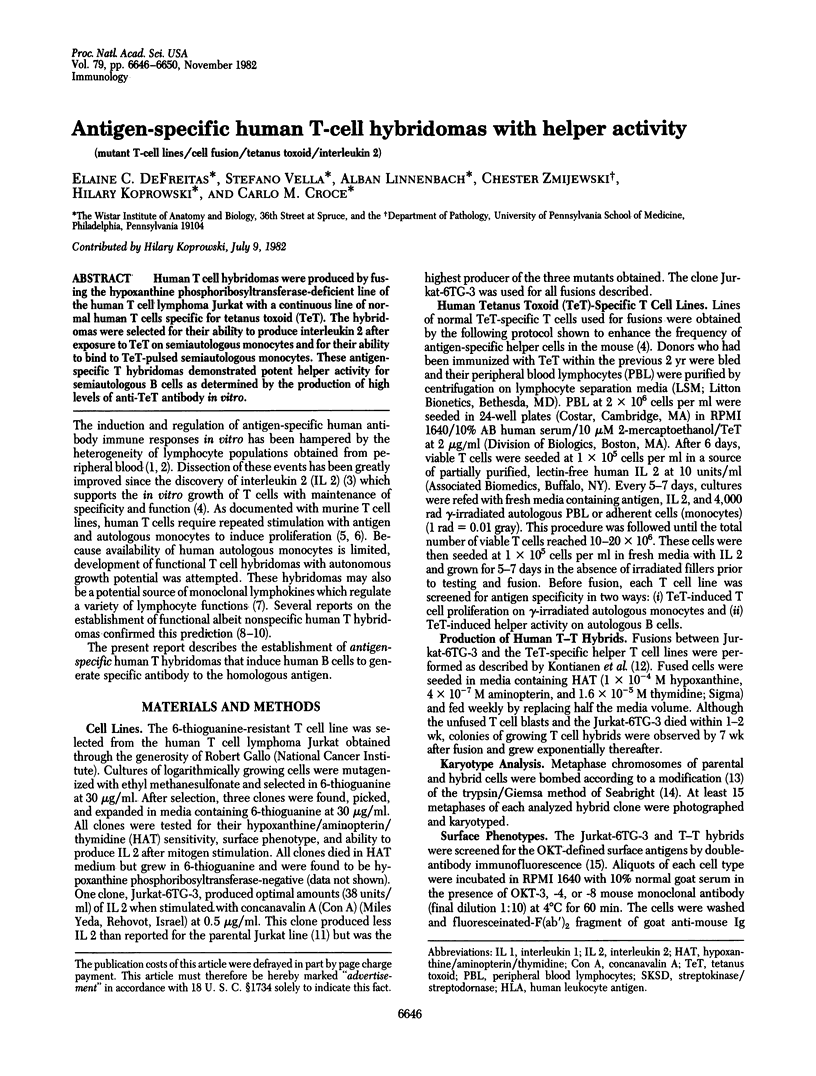
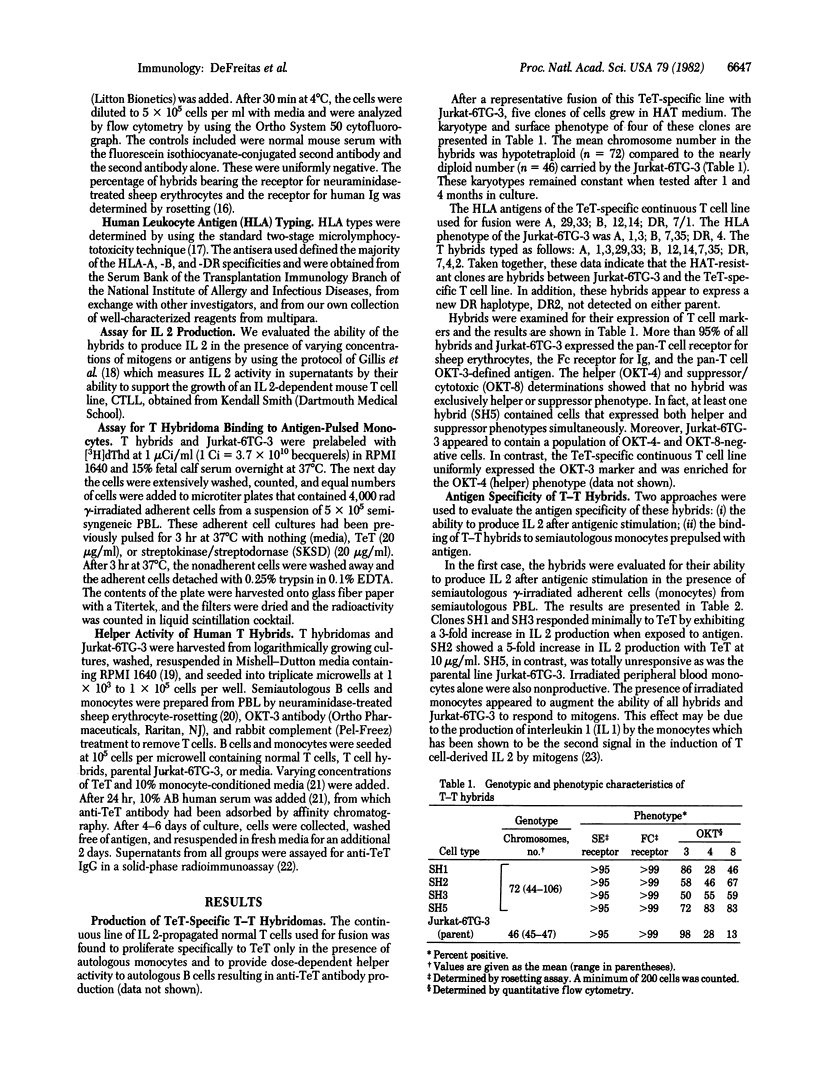
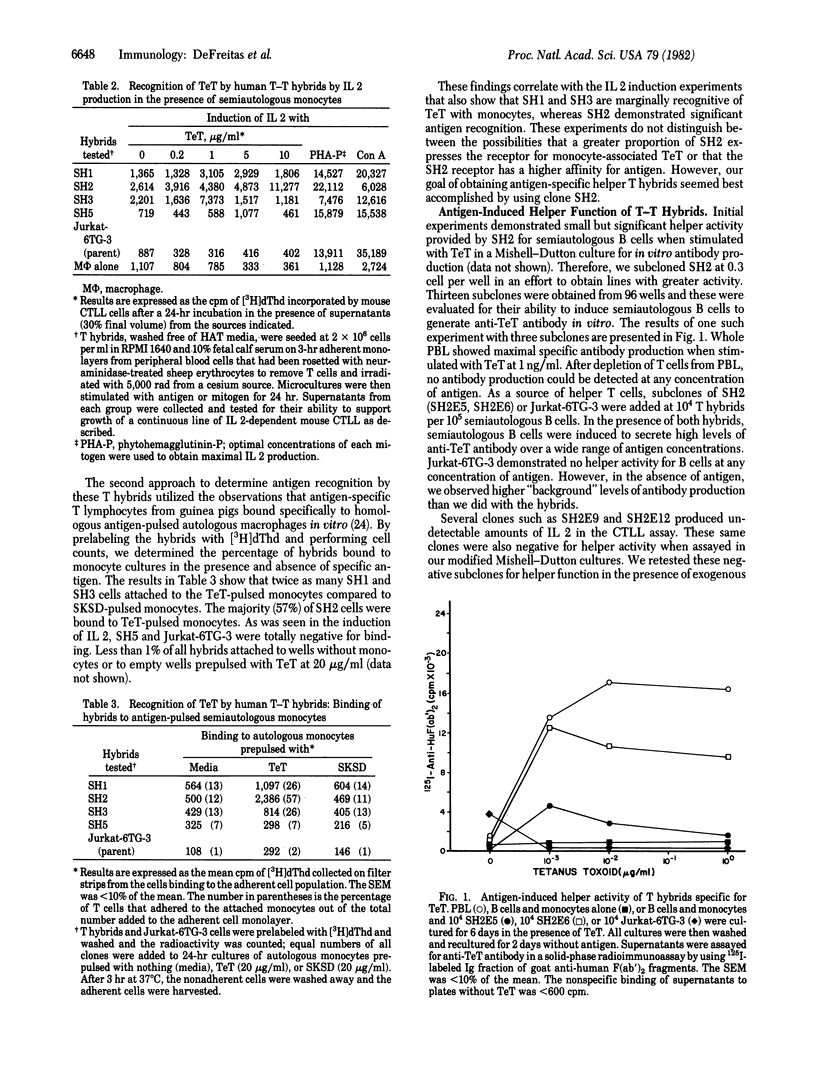
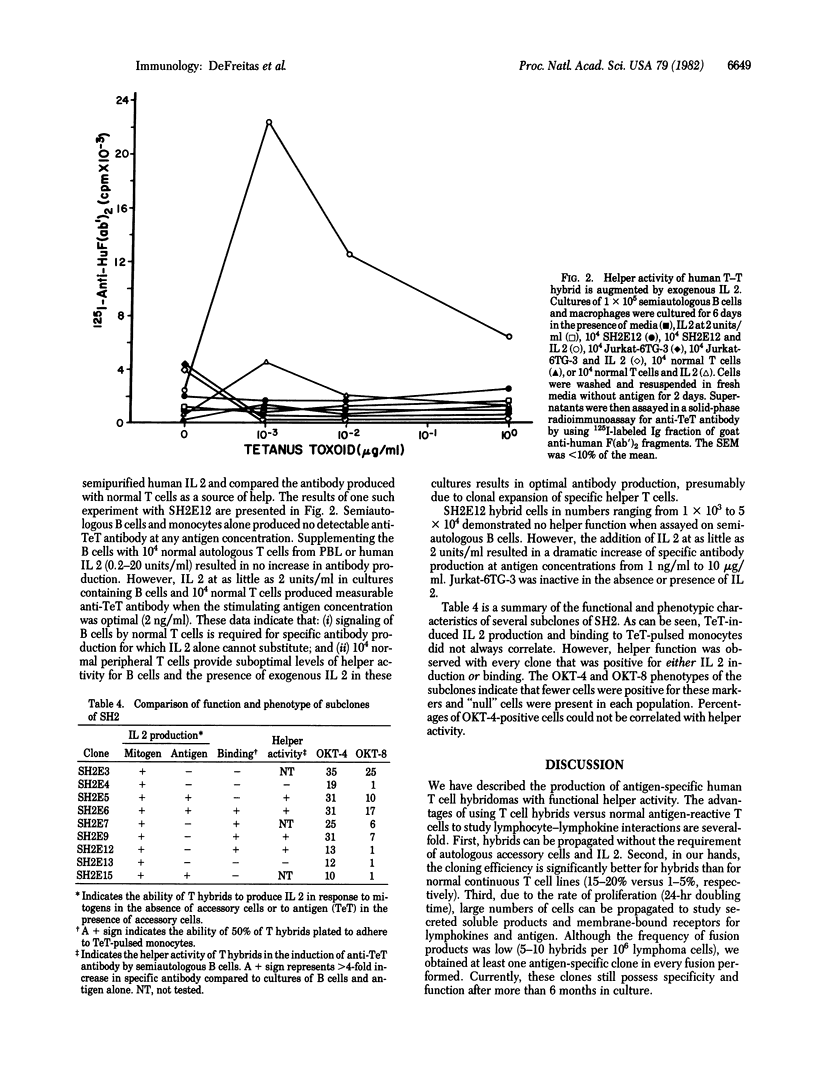
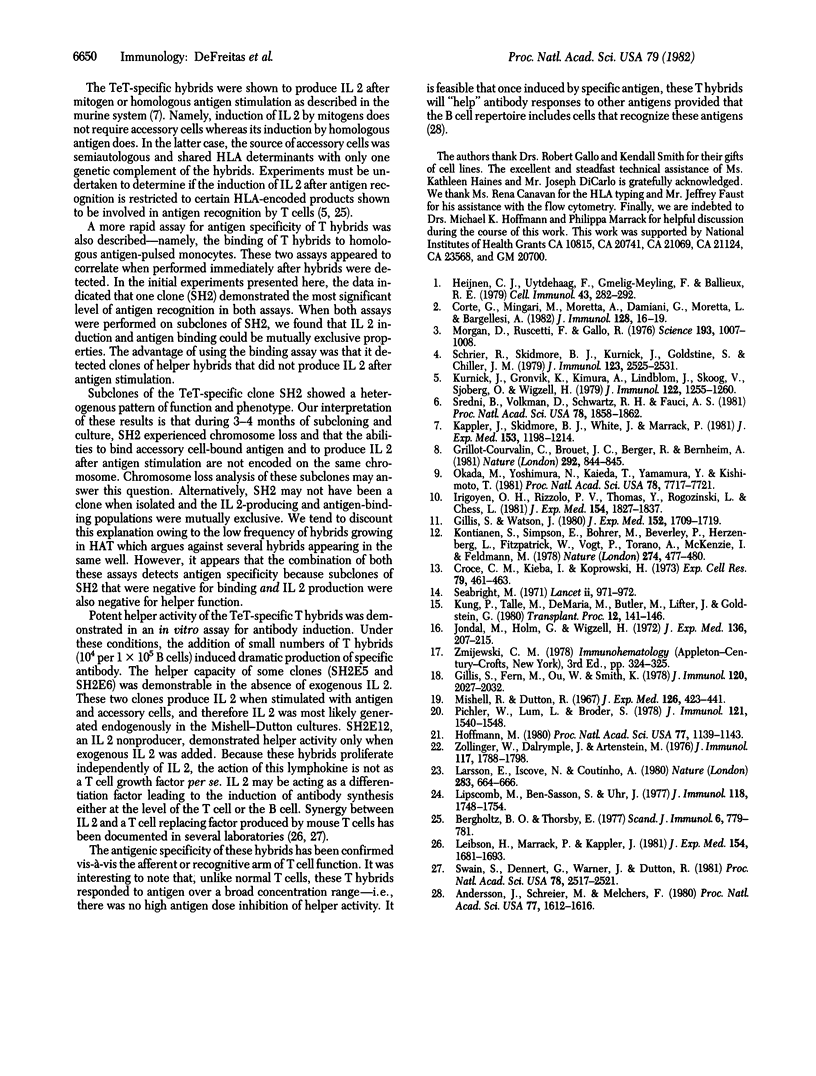
Selected References
These references are in PubMed. This may not be the complete list of references from this article.
- Andersson J., Schreier M. H., Melchers F. T-cell-dependent B-cell stimulation is H-2 restricted and antigen dependent only at the resting B-cell level. Proc Natl Acad Sci U S A. 1980 Mar;77(3):1612–1616. doi: 10.1073/pnas.77.3.1612. [DOI] [PMC free article] [PubMed] [Google Scholar]
- Bergholtz B. O., Thorsby E. Macrophage-dependent response of immune human T lymphocytes to PPD in vitro. Influence of HLA-D histocompatibility. Scand J Immunol. 1977;6(8):779–786. doi: 10.1111/j.1365-3083.1977.tb02151.x. [DOI] [PubMed] [Google Scholar]
- Corte G., Mingari M. C., Moretta A., Damiani G., Moretta L., Bargellesi A. Human T cell subpopulations defined by a monoclonal antibody. I. A small subset is responsible for proliferation to allogeneic cells or to soluble antigens and for helper activity for B cell differentiation. J Immunol. 1982 Jan;128(1):16–19. [PubMed] [Google Scholar]
- Croce C. M., Kieba I., Koprowski H. Unidirectional loss of human chromosomes in rat-human hybrids. Exp Cell Res. 1973 Jun;79(2):461–463. doi: 10.1016/0014-4827(73)90470-9. [DOI] [PubMed] [Google Scholar]
- Gillis S., Ferm M. M., Ou W., Smith K. A. T cell growth factor: parameters of production and a quantitative microassay for activity. J Immunol. 1978 Jun;120(6):2027–2032. [PubMed] [Google Scholar]
- Gillis S., Watson J. Biochemical and biological characterization of lymphocyte regulatory molecules. V. Identification of an interleukin 2-producing human leukemia T cell line. J Exp Med. 1980 Dec 1;152(6):1709–1719. doi: 10.1084/jem.152.6.1709. [DOI] [PMC free article] [PubMed] [Google Scholar]
- Grillot-Courvalin C., Brouet J. C., Berger R., Bernheim A. Establishment of a human T-cell hybrid line with suppressive activity. Nature. 1981 Aug 27;292(5826):844–845. doi: 10.1038/292844a0. [DOI] [PubMed] [Google Scholar]
- Heijnen C. J., UytdeHaag F., Gmelig-Meyling F. H., Ballieux R. E. Localization of human antigen-specific helper and suppressor function in distinct T-cell subpopulations. Cell Immunol. 1979 Mar 15;43(2):282–292. doi: 10.1016/0008-8749(79)90173-4. [DOI] [PubMed] [Google Scholar]
- Hoffmann M. K. Antigen-specific induction and regulation of antibody synthesis in cultures of human peripheral blood mononuclear cells. Proc Natl Acad Sci U S A. 1980 Feb;77(2):1139–1143. doi: 10.1073/pnas.77.2.1139. [DOI] [PMC free article] [PubMed] [Google Scholar]
- Irigoyen O., Rizzolo P. V., Thomas Y., Rogozinski L., Chess L. Generation of functional human T cell hybrids. J Exp Med. 1981 Dec 1;154(6):1827–1837. doi: 10.1084/jem.154.6.1827. [DOI] [PMC free article] [PubMed] [Google Scholar]
- Jondal M., Holm G., Wigzell H. Surface markers on human T and B lymphocytes. I. A large population of lymphocytes forming nonimmune rosettes with sheep red blood cells. J Exp Med. 1972 Aug 1;136(2):207–215. doi: 10.1084/jem.136.2.207. [DOI] [PMC free article] [PubMed] [Google Scholar]
- Kappler J. W., Skidmore B., White J., Marrack P. Antigen-inducible, H-2-restricted, interleukin-2-producing T cell hybridomas. Lack of independent antigen and H-2 recognition. J Exp Med. 1981 May 1;153(5):1198–1214. doi: 10.1084/jem.153.5.1198. [DOI] [PMC free article] [PubMed] [Google Scholar]
- Kontiainen S., Simpson E., Bohrer E., Beverley P. C., Herzenberg L. A., Fitzpatrick W. C., Vogt P., Torano A., McKenzie I. F., Feldmann M. T-cell lines producing antigen-specific suppressor factor. Nature. 1978 Aug 3;274(5670):477–480. doi: 10.1038/274477a0. [DOI] [PubMed] [Google Scholar]
- Kung P. C., Talle M. A., DeMaria M. E., Butler M. S., Lifter J., Goldstein G. Strategies for generating monoclonal antibodies defining human t-lymphocyte differentiation antigens. Transplant Proc. 1980 Sep;12(3 Suppl 1):141–146. [PubMed] [Google Scholar]
- Kurnick J. T., Grönvik K. O., Kimura A. K., Lindblom J. B., Skoog V. T., Sjöberg O., Wigzell H. Long term growth in vitro of human T cell blasts with maintenance of specificity and function. J Immunol. 1979 Apr;122(4):1255–1260. [PubMed] [Google Scholar]
- Larsson E. L., Iscove N. N., Coutinho A. Two distinct factors are required for induction of T-cell growth. Nature. 1980 Feb 14;283(5748):664–666. doi: 10.1038/283664a0. [DOI] [PubMed] [Google Scholar]
- Leibson H. J., Marrack P., Kappler J. W. B cell helper factors. I. Requirement for both interleukin 2 and another 40,000 mol wt factor. J Exp Med. 1981 Nov 1;154(5):1681–1693. doi: 10.1084/jem.154.5.1681. [DOI] [PMC free article] [PubMed] [Google Scholar]
- Lipscomb M. F., Ben-Sasson S. Z., Uhr J. W. Specific binding of T lymphocytes to macrophages. I. Kinetics of binding. J Immunol. 1977 May;118(5):1748–1754. [PubMed] [Google Scholar]
- Mishell R. I., Dutton R. W. Immunization of dissociated spleen cell cultures from normal mice. J Exp Med. 1967 Sep 1;126(3):423–442. doi: 10.1084/jem.126.3.423. [DOI] [PMC free article] [PubMed] [Google Scholar]
- Morgan D. A., Ruscetti F. W., Gallo R. Selective in vitro growth of T lymphocytes from normal human bone marrows. Science. 1976 Sep 10;193(4257):1007–1008. doi: 10.1126/science.181845. [DOI] [PubMed] [Google Scholar]
- Okada M., Yoshimura N., Kaieda T., Yamamura Y., Kishimoto T. Establishment and characterization of human T hybrid cells secreting immunoregulatory molecules. Proc Natl Acad Sci U S A. 1981 Dec;78(12):7717–7721. doi: 10.1073/pnas.78.12.7717. [DOI] [PMC free article] [PubMed] [Google Scholar]
- Pichler W. J., Lum L., Broder S. Fc-receptors on human T lymphocytes. I. Transition of Tgamma to Tmu cells. J Immunol. 1978 Oct;121(4):1540–1548. [PubMed] [Google Scholar]
- Schrier R. D., Skidmore B. J., Kurnick J. T., Goldstine S. N., Chiller J. M. Propagation of antigen-specific T cell helper function in vitro. J Immunol. 1979 Dec;123(6):2525–2531. [PubMed] [Google Scholar]
- Seabright M. A rapid banding technique for human chromosomes. Lancet. 1971 Oct 30;2(7731):971–972. doi: 10.1016/s0140-6736(71)90287-x. [DOI] [PubMed] [Google Scholar]
- Sredni B., Volkman D., Schwartz R. H., Fauci A. S. Antigen-specific human T-cell clones: development of clones requiring HLA-DR-compatible presenting cells for stimulation in presence of antigen. Proc Natl Acad Sci U S A. 1981 Mar;78(3):1858–1862. doi: 10.1073/pnas.78.3.1858. [DOI] [PMC free article] [PubMed] [Google Scholar]
- Swain S. L., Dennert G., Warner J. F., Dutton R. W. Culture supernatants of a stimulated T-cell line have helper activity that acts synergistically with interleukin 2 in the response of B cells to antigen. Proc Natl Acad Sci U S A. 1981 Apr;78(4):2517–2521. doi: 10.1073/pnas.78.4.2517. [DOI] [PMC free article] [PubMed] [Google Scholar]
- Zollinger W. D., Dalrymple J. M., Artenstein M. S. Analysis of parameters affecting the solid phase radioimmunoassay quantitation of antibody to meningococcal antigens. J Immunol. 1976 Nov;117(5 PT2):1788–1798. [PubMed] [Google Scholar]


